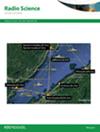基于光子晶体的分形贴片天线用于智能交通系统中增强毫米波通信
IF 1.5
4区 地球科学
Q3 ASTRONOMY & ASTROPHYSICS
引用次数: 0
摘要
考虑到毫米波在车联网(V2X)网络中的应用的重要性,本文介绍了一种用于智能交通系统(ITS)毫米波频段的集成光子晶体(PhC)分形贴片天线(FPA),我们假设,作为例子,天线被设计为在三个频段:31.42 GHz, 37.76 GHz和38.92 GHz共振。该天线的增益为10.88 dBi,工作频率为38.92 GHz,显示出良好的信号接收和传输能力,预计这对ITS操作非常重要。天线带宽覆盖多个频段,可在毫米波V2X应用中实现多功能通信。为了评估天线的性能,我们对其配置进行了详细的分析。这包括对带和不带PhC集成的天线的比较,以及对矩形晶格结构的探索。此外,还研究了井眼尺寸和井距的变化,以评估它们对增益和反射系数等关键参数的影响。分形几何和PhC结构的集成产生了适用于毫米波通信的紧凑、高性能天线。分形几何和PhC结构的集成使得毫米波通信应用更加紧凑和高性能。通过仿真和分析,包括辐射方向图、增益和反射系数图的评估,对天线的性能进行了全面评估。该研究强调了拟议的FPA-PhC天线配置的潜力,以增强ITS内部的通信网络,在毫米波频段的支持下显着推进ITS系统。本文章由计算机程序翻译,如有差异,请以英文原文为准。
Fractal patch antenna based on photonic crystal for enhanced millimeter-wave communication in intelligent transportation systems
This paper introduces a Fractal Patch Antenna (FPA) integrated with Photonic Crystals (PhC) designed for Intelligent Transportation Systems (ITS) in the Millimeter-wave bands (mmWaves) given the importance of the application of mmWaves in Vehicle-to-Everything (V2X) networks, we assumed, as examples, that the antenna is designed to resonate at three frequency bands: 31.42 GHz, 37.76 GHz, and 38.92 GHz. With a gain of 10.88 dBi, at 38.92 GHz, the antenna demonstrates promising signal reception and transmission capabilities, which are anticipated to be important for ITS operations. The antenna bandwidth covers multiple frequency bands, enabling versatile communication in mmWaves V2X applications. To evaluate the performance of the antenna, we conducted a detailed analysis of its configuration. This included a comparison of the antenna with and without the PhC integration, as well as an exploration of rectangular lattice structure. In addition, variations in hole sizes and spacing were examined to assess their impact on key parameters such as the gain and reflection coefficient. The integration of fractal geometry and PhC structures results in a compact, high-performance antenna suitable for mmWave communication. The integration of fractal geometry and PhC structure results in compactness and high performance in mmWaves communication applications. Through simulation and analysis, including radiation pattern, gain, and reflection coefficient plot assessment, the antenna performance is thoroughly evaluated. The study highlights the potential of the proposed FPA-PhC antenna configuration to enhance communication networks within the ITS, significantly advancing the ITS system with support from the mmWave bands.
求助全文
通过发布文献求助,成功后即可免费获取论文全文。
去求助
来源期刊

Radio Science
工程技术-地球化学与地球物理
CiteScore
3.30
自引率
12.50%
发文量
112
审稿时长
1 months
期刊介绍:
Radio Science (RDS) publishes original scientific contributions on radio-frequency electromagnetic-propagation and its applications. Contributions covering measurement, modelling, prediction and forecasting techniques pertinent to fields and waves - including antennas, signals and systems, the terrestrial and space environment and radio propagation problems in radio astronomy - are welcome. Contributions may address propagation through, interaction with, and remote sensing of structures, geophysical media, plasmas, and materials, as well as the application of radio frequency electromagnetic techniques to remote sensing of the Earth and other bodies in the solar system.
 求助内容:
求助内容: 应助结果提醒方式:
应助结果提醒方式:


